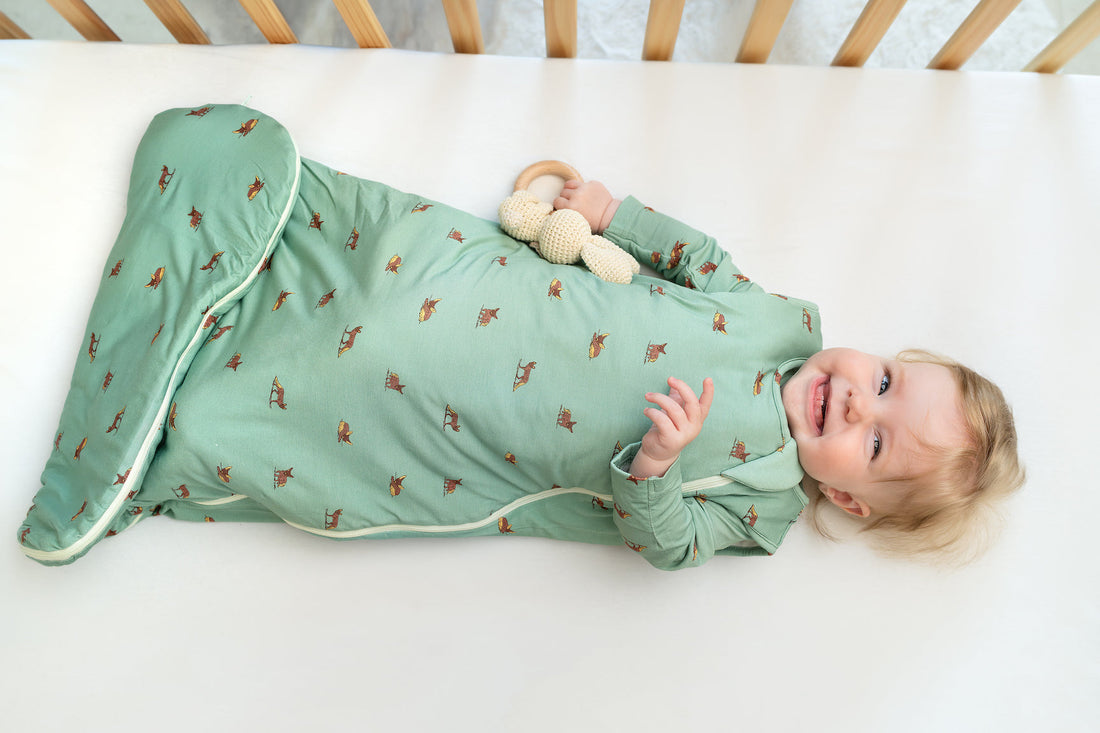
How should your Hushabye Sleep Bag Fit?
Share
The American Academy of Pediatrics (AAP) recommends that your baby’s crib has nothing loose in it apart from a tight fitted sheet until they’re over 12 months old. They have a preference for baby sleep bags or sleep sacks as it’s a safe and convenient way to keep your infant warm while they sleep. Unlike loose blankets and quilts, which can accidentally cover a baby's face and pose a suffocation risk, wearable blankets like a sleep bag are designed to fit snugly around your baby's body. This eliminates the risk of baby pulling the fabric over their face during sleep.
All babies come in different shapes and sizes, however our guidelines will help ensure that your wearable blanket is safe and is the proper size for your baby.
Measurements
We recommend what sleep bag to use based on your child’s weight and height.
You may be tempted to size up to get more use out of your baby sleep sack, but you do not want to risk buying something that is too large to be safe for your little one. The good news though is that our Hushabye Sleep Bags in size M and L come with poppers to adjust the length so it can grow with your baby - meaning you don’t have to move to the next size for a while.
Fit test
- Make sure it’s not too loose at the neck and that it can’t pull over and cover your baby’s mouth or nose. If you pull the neck hole up towards their mouth, we want to see it falling back down into the correct placement on their chest.
- Make sure it’s not too loose around the arms/neck so that the baby cannot slip into the bag. Most of our Hushabye sleep bags come with arm poppers that allow you to reduce the size of the arm holes if needed.
- To ensure proper hip development, make sure there’s enough space for their legs and hips to move and bend their knees outwards to the side if needed. There should also be extra material by their feet to allow for growth.
Temperature check
It’s important to not let your baby get too hot to reduce the likelihood of Sudden Infant Death Syndrome (SIDS). Ensure that the room your baby sleeps in is at a comfortable temperature. The recommended room temperature for a baby's sleep environment according to the AAP is typically between 20°C and 22°C (68°F and 72°F ). You’ll want to choose the right TOG for their wearable blanket for improved comfort and safety while sleeping. Check out our TOG guide to find what’s right for your baby.
You can look for the following signs to help you ensure your baby isn’t too warm:
- Check Their Skin: particularly their neck or back, with the back of your hand. It should be warm but not sweaty or overly hot. Cold or clammy skin is a sign they may be too cold, while sweating or flushed skin may indicate they are too hot.
- Feel Their Chest and Back: Gently place your hand on your baby's chest or back, underneath their clothing or sleepwear. It should feel warm and comfortable, not too hot or cold.
- Check Their Extremities: Babies often have cooler hands and feet, which is normal. However, if their hands and feet are excessively cold or turning bluish, it may be a sign they need additional warmth. Our Hushabye Zippered sleep suits have foldable mittens and footies which let you cover their hands or feet or keep them out in line with their temperature.
- Observe Their Sleep Behaviour: If your baby is constantly waking up, fussing, or restless, it may be due to discomfort from being too hot or too cold.
- Check Their Nose and Ears: They should be warm but not overly so. Extremely cold or hot ears and nose can be an indicator of temperature discomfort.
- Monitor Their Breathing: Rapid or shallow breathing can be a sign that your baby is too hot. Ensure that their breathing is steady and regular.
- Pay Attention to Cues: Babies communicate their discomfort through cues like crying, fussiness, or restlessness. If your baby is showing signs of distress, it's essential to check their temperature and adjust their clothing or bedding as needed.
A good rule of thumb for dressing your baby for warmth is adding one extra layer of clothing then you would wear yourself in that temperature. So if you are comfortable in shorts and a t-shirt, then maybe dress your infant in joggers and a long sleeved top.
To ensure you are getting the right fit for your baby, it’s important to check their measurements to see what size of Hushabye sleep bag is suggested, do a fit test when it arrives and make sure that temperature considerations are kept in mind for comfortable and safe sleep for your baby. If you think your Hushabye sleep bag is not the correct size, you can exchange it for another size if you haven’t removed the labels yet! Just let us know at hello@husuabye-baby.com.

